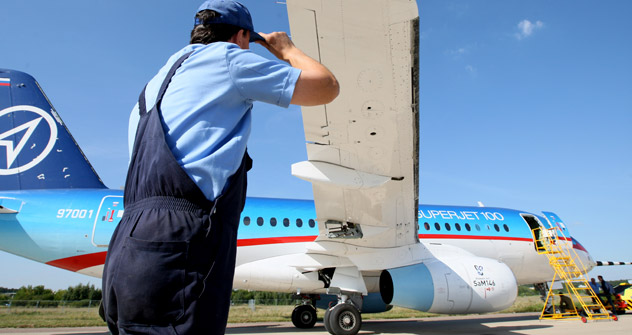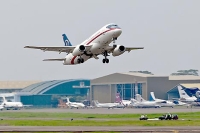Superjet – Down but not out?

What consequences will the Sukhoi SuperJet crash have on the development of Russia's aviation business. Source: RIA Novosti / Alexey Kudenko
Since Russia’s most advanced new aircraft, the Sukhoi Superjet 100, crashed in Indonesia, experts have been asking if the accident heralds disaster for the entire Russian aviation industry or if the Superjet project can overcome the crash’s bad publicity.
One of the main questions that aviation specialists have been asking themselves is how the plane, filled with state-of-the-art electronics and guided by the best test pilots, could have missed a mountain. The Superjet uses all the latest global security innovations, in particular the traffic collision avoidance system (TCAS) and the terrain awareness and warning system (TAWS).
“Third and fourth generation alert systems are installed in all modern planes, including the Superjet,” said Rafail Aptukov, president of Flight Security Partnership. “They are much more precise and better protected from interference; they include unique logical combinations calculated for various in-flight emergencies. They are designed to alert the pilot of a potential collision in good time, so he can avoid it.”
Aviation specialists have wondered whether the local controllers did their best. Some pilots claim that both in Indonesia and the Philippines controllers say “Approved” in response to almost any call from the crew.
“I am also concerned that there have been seven plane crashes near Jakarta during the last decade,” Aptukov said.
So far, there are only unofficial versions of what happened. The official report will appear only after the Indonesian authorities, the Russian Industry and Trade Ministry (supported by the Foreign Ministry), Investigation Committee specialists and experts of the Interstate Aviation Committee (MAC) complete their investigation. But there is no prospective date for the issuance of the official report, as Indonesian salvage teams have said that accessing the crash site is extremely difficult due to the terrain. This will make it harder to recover both large pieces of debris and smaller parts of the plane. Without these, it will be hard to gain a real picture of the tragedy. In the best-case scenario, the official version will not be ready for several months; in the worst case, the world may never learn what really happened to the plane.
Business laws
Globally, the market for medium-range aircraft is the most competitive, and the Superjet was intended to vault Russia to the top of that segment. In the aftermath of the crash, Russian aviation experts and foreign buyers alike are reassessing Russia’s prospects.
The investigation into the disaster had hardly begun when Indonesia’s Kartika Airlines, which specializes in domestic air travel, said it might postpone indefinitely its order for 30 Sukhoi aircraft. Kartika was the first company in Southeast Asia to buy the Superjet; it placed a $951 million order in July 2010. The first deliveries were expected in September.
Sky Aviation, another Indonesian air carrier had reached an agreement to buy 12 Superjets, It has not yet commented on the status of its order, but experts are certain its response will be identical to that of Kartika. As of today, hard contracts are in place for the delivery of 168 jets to Russian and foreign air carriers and there are preliminary contracts and agreements of intent to buy about 130 Superjets from carriers in Spain, the United States and Thailand. Experts are divided over whether these contracts will be cancelled or whether the carriers will deal with the fallout of the crash in a different way.
“The declaration of the Indonesian company about suspension of deliveries perfectly illustrates the popular slogan ‘nothing personal, just business,’” said Ruslan Syroedov, who works for a company specializing in lease operations. “You involuntarily pay attention to the possible causes of the crash that were mentioned after the accident – engine failure, faults in the navigation and control systems, while nothing was said about mistakes by the pilots or controllers. This is a clear signal that they will be seeking new discounts and concessions from the supplier. This is a normal situation for the market, especially the Asian market, where you should benefit from your business partner’s mistakes.”
Boris Bychkov, general director of loss adjustment consultancy Airclaims CIS, believes that in the long term, the crash will not have too much of an effect on the sales. “Longer-term business projects are little affected by such incidents,” he said. “The crash will not become a decisive factor for the buyers to terminate contracts. An accident during test flights is no reason to bury the plane. Public opinion may produce an impact, though, especially if we are talking about a company enjoying state support, as political motives can interfere. But I can’t rule out that customers might want additional discounts.”
Air carriers are normally very pragmatic. If an airplane has a type certificate, then there is sufficient proof that it meets all security standards. In February 2012, the Sukhoi Superjet 100 received the Type Certificate from the European Aviation Safety Agency (EASA), meaning that it complies with the standards that all alternative producers have to meet.
Another important reason the contracts are likely to hold is that Sukhoi currently supplies the most competitive medium-range aircraft for domestic operations.
Small as it might be, the Superjet has an impressive range. It falls just out of the regional class, with a capacity of up to 100 passengers and range of 4,500 kilometers, which is why Sukhoi Civil Aircraft believes that most of the demand for its jets will come from Southeast Asia. Distances are huge between islands in the region, which means that the Russian Superjet will be a welcome option for local carriers.
Secretary General of the Indonesia National Air Carrier Association (INACA) Tengku Burhanuddin has already stated that the crash would not affect the demand for this model. “We need such planes to connect our cities,” he said.
Sukhoi’s competitors in this market segment, most of which are still in development, are generally more expensive. They include Brazil’s Embraer E-Jets (priced at $28.5-40 million), Canada’s Bombardier CSeries ($58.28-66.57 million), China’s ARJ21 (price not disclosed yet), Russia’s An-148 ($24-25 million), Tu-334 and Japan’s Mitsubishi Regional Jet.
The Sukhoi Superjet 100 is available at an average price of $35.4-36.2 million. Additionally, of these planes, the Superjet is the first one to begin flying, so it is already known to buyers. “It was the first plane to start flying, and it is already in commercial service,” said Bychkov. “For all I know, the Chinese have had few orders so far, and the Bombardier and Mitsubishi models are not flying yet – they have just started making the planes and have a few years of tests ahead.”
Bets have been placed
The crash has produced an adverse impact on the image of the brand; yet many specialists argue that accidents of this kind have happened to many international producers, which managed to deal with the trouble with their heads held high and pride intact.
“Airbus also had problems during trial flights,” Bychkov said. “The A320 had a crash, and there were troubles with the A380. Boeing had a fire on board a Boeing-787 during trials, before the plane was supplied to Japan. The contracts remained in place.”
Ruslan Gusarov, editor-in-chief of Avia.ru, however, thinks that Sukhoi may have reason to worry. “There have been be crashes that effectively put an end to new projects,” Gusarov said. “Take the Tu-144 crash in Le Bourget. The plane never regained the trust of foreign buyers. So the accident in Indonesia might tarnish the image not only of the machine, but also the entire aviation industry in the country.”
For its part, Sukhoi Civil Aircraft will be doing its best to deliver the contracted planes. “The Sukhoi brand is famous not only for its civil aircraft, but also military products,” said Olga Kayukova, head of the United Aircraft Corporation press service. “It is backed by a 70-year reputation. As for the Sukhoi Superjet 100 brand, it has excellent prospects and will be able to find a firm footing in the market.”
At the same time, some experts see alarming symptoms in the Indonesian crash: “We placed all our bets on a single plane during the last decade, and all our hopes rest with the Superjet now,” Gusarov said. “We put all our eggs in one basket and may be left with nothing. This policy is fraught with risks for the development of Russia’s entire civil aviation industry.”
This
article is abridged and originally appeared in Itogi. It can be found in the original Russian
here.
All rights reserved by Rossiyskaya Gazeta.
Subscribe
to our newsletter!
Get the week's best stories straight to your inbox

